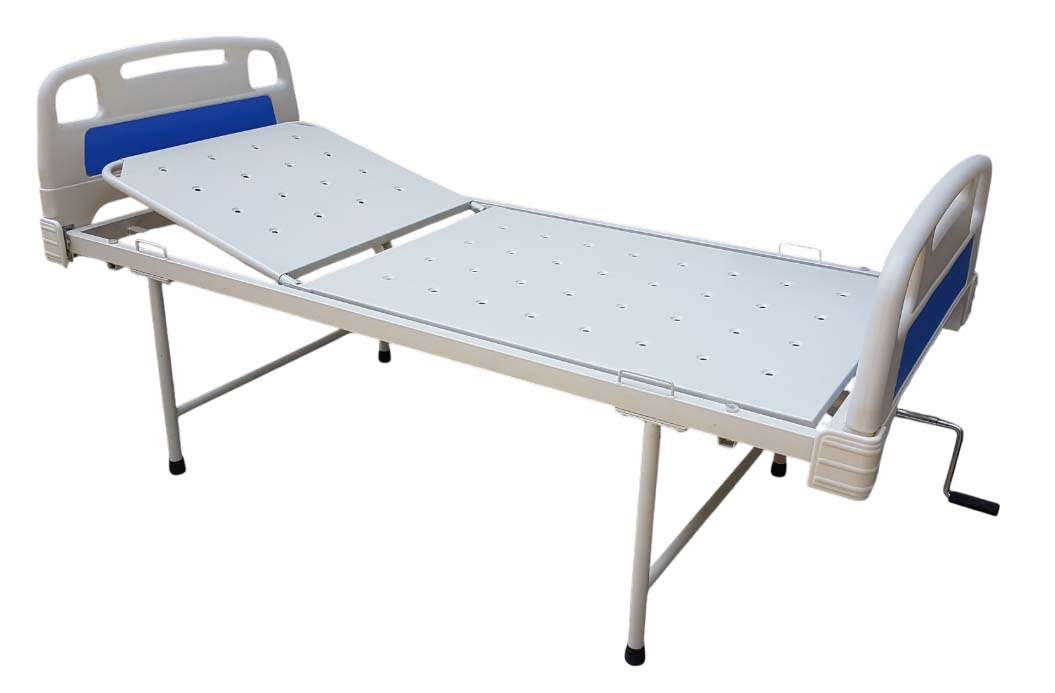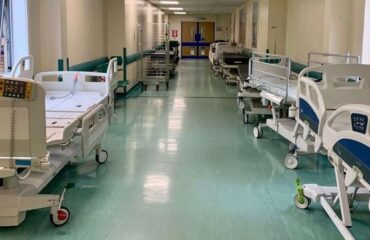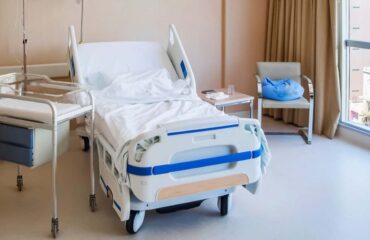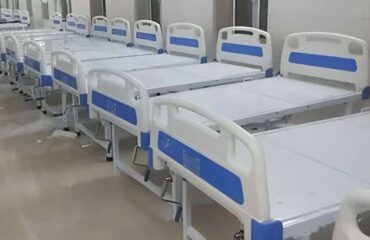A Fowler bed is a type of hospital bed designed to provide comfort and support to patients who need to rest in a semi-reclined position. It allows the head and upper body to be elevated at various angles, improving breathing, circulation, and overall comfort. The bed is named after Dr. George Ryerson Fowler, who introduced the Fowler’s position in medical care.

Types of Fowler Beds
Fowler beds are designed to provide comfort and medical support by allowing adjustable positioning. They come in different types, each catering to specific patient needs and healthcare settings. Below is a detailed breakdown of the types of Fowler beds:
Manual Fowler Bed
- Mechanism: Operated using a mechanical crank system.
- Adjustability: Head and leg sections can be adjusted manually.
Features:
- Cost-effective and durable.
- Suitable for general patient care.
- Requires physical effort from caregivers to adjust the bed.
Best for: Hospitals, clinics, and home care where budget is a concern.
Semi-Fowler Bed
- Mechanism: Can be manual or electric.
- Adjustability: Only the head section can be raised (typically up to 45 degrees).
Features:
- Provides basic elevation for patients.
- Helps in breathing, eating, and minor medical procedures.
- No leg elevation function.
Best for: Patients who need mild upper body elevation, post-operative recovery, and general comfort.
Full Fowler Bed
- Mechanism: Can be manual or electric.
- Adjustability: Both the head and leg sections are adjustable.
Features:
- Offers multiple reclining positions.
- Enhances patient mobility and comfort.
- Reduces pressure sores by changing positions regularly.
Electric Fowler Bed
- Mechanism: Operated via a remote control or buttons.
- Adjustability: Both head and leg sections can be adjusted electronically.
Features:
- Effortless positioning adjustment.
- Ideal for elderly and immobile patients.
- Can include additional features like height adjustment and side rails.
ICU Fowler Bed
- Mechanism: Fully automated, motorized control.
- Adjustability: Multi-position settings for head, leg, and even Trendelenburg position (tilted bed).
Features:
- High-tech features such as electronic controls, oxygen holders, and IV poles.
- Adjustable height for easy patient transfer.
- Side rails and wheels for patient safety.
Pediatric Fowler Bed
- Mechanism: Manual or electric.
- Adjustability: Head and leg elevation with child-friendly safety features.
Features:
- Smaller size designed for children.
- Additional protective side rails.
- Comfortable and secure for pediatric patients.
Bariatric Fowler Bed
- Mechanism: Heavy-duty manual or electric operation.
- Adjustability: Head, leg, and height adjustments.
Features:
- Extra-wide and reinforced frame to support overweight patients.
- Stronger motors for smooth adjustments.
- May include air mattresses to prevent pressure sores.
Benefits of Fowler Beds
Fowler beds are widely used in hospitals, nursing homes, and home care settings due to their numerous medical and comfort-related benefits. These beds allow patients to be positioned at various angles, enhancing their overall well-being. Below are the detailed benefits of Fowler beds:
Improved Breathing & Lung Function
How it helps:
- Elevating the upper body improves lung expansion, making it easier for patients to breathe.
- Reduces pressure on the diaphragm, allowing the lungs to function more efficiently.
- Beneficial for patients with asthma, pneumonia, chronic obstructive pulmonary disease (COPD), or sleep apnea.
Best for:
- Patients with respiratory disorders
- Post-surgery patients needing oxygen therapy
- Elderly individuals with breathing difficulties
Enhanced Circulation & Blood Flow
How it helps:
- Adjusting the leg section can reduce swelling in the lower body.
- Elevating the head and legs prevents blood pooling, reducing the risk of deep vein thrombosis (DVT).
- Ensures proper blood flow to the heart, lowering the risk of complications in cardiac patients.
Best for:
- Patients recovering from heart surgery or stroke
- Individuals prone to edema (swelling in legs)
- Patients with low blood pressure or circulatory issues
Prevention of Bedsores (Pressure Ulcers)
How it helps:
- Frequent repositioning reduces prolonged pressure on bony areas (back, hips, heels, elbows).
- Encourages better skin ventilation, preventing excessive sweating and friction.
- Reduces the risk of infections and skin breakdown in immobile patients.
Best for:
- Paralyzed or bedridden patients
- Elderly individuals in long-term care
- Patients with limited mobility due to fractures or neurological disorders
Easier Digestion & Reduced Acid Reflux
How it helps:
- Keeping the upper body elevated prevents stomach acid from traveling back into the esophagus, reducing acid reflux and GERD (Gastroesophageal Reflux Disease).
- Helps with proper digestion and bowel movement by preventing food from sitting too long in the stomach.
- Reduces the risk of aspiration pneumonia, which occurs when food or liquid enters the lungs.
Best for:
- Patients suffering from GERD, acid reflux, or hiatal hernia
- Post-surgery patients recovering from abdominal procedures
- Stroke patients with swallowing difficulties
Comfort & Pain Relief
How it helps:
- Allows patients to adjust their position easily, reducing discomfort and stiffness.
- Helps in pain management by taking pressure off sore areas.
- Makes activities like reading, eating, and watching TV more comfortable.
Best for:
- Post-operative patients with wounds or surgical stitches
- Individuals with arthritis or chronic pain conditions
- Patients recovering from spinal injuries or back pain
Easier Patient Care & Mobility
How it helps:
- Caregivers can easily reposition patients without excessive strain.
- The adjustable height feature in some models allows smooth patient transfers from bed to wheelchair.
- Reduces the risk of caregiver injuries caused by heavy lifting.
Best for:
- Patients in ICUs and long-term care settings
- Elderly individuals needing assistance with daily activities
- People recovering from fractures, paralysis, or neurological disorders
Faster Recovery Post-Surgery
How it helps:
- Elevating the legs and head reduces swelling and pain after surgery.
- Helps in wound healing by improving circulation.
- Supports rehabilitation exercises by allowing controlled movement.
Best for:
- Orthopedic surgery patients (hip/knee replacement)
- Abdominal or chest surgery patients
- Individuals recovering from spinal surgeries
Enhanced Safety & Fall Prevention
How it helps:
- Side rails on ICU and electric Fowler beds prevent patients from rolling out of bed.
- Adjustable height reduces the risk of falls while getting in and out of bed.
- Lockable wheels ensure stability and patient safety.
Best for:
- Elderly patients prone to falls
- Patients with dementia or confusion
- ICU patients who need constant monitoring
Better Sleep Quality
How it helps:
- Customizable positions allow patients to find a comfortable sleeping posture.
- Helps in reducing snoring and sleep apnea symptoms.
- Provides relief from body aches and pressure points during sleep.
Best for:
- Elderly individuals with sleep disorders
- Patients recovering from major illnesses or injuries
- People experiencing chronic pain or insomnia
Hospital Equipment Mfg. Co. – Hospital Beds Furniture in India
Hospital Equipment Manufacturing Company (HEMC), established in 1981, is a prominent Indian manufacturer and exporter of medical and hospital equipment, including a diverse range of hospital beds.
Product Range:
HEMC offers various hospital beds designed to meet the specific needs of patients and healthcare facilities:
Electric Beds: Feature electronic adjustments for height, head, and foot positions, enhancing patient comfort and caregiver convenience.
Manual Beds: Equipped with mechanical systems for adjusting bed positions, providing cost-effective solutions without compromising functionality.
Semi-Electric Beds: Combine electric controls for head and foot adjustments with manual height adjustments, offering a balance between functionality and affordability.
ICU Beds: Designed with advanced features such as integrated patient monitoring systems and multiple positioning options to cater to critical care requirements.
Pediatric Beds: Specifically crafted for children, these beds prioritize safety and comfort with appropriate sizing and protective features.
Quality Assurance:
HEMC emphasizes high-quality materials and rigorous testing to ensure durability and safety. Their products comply with international healthcare standards, reflecting their commitment to quality.
Customer Support:
The company offers comprehensive customer support, from initial consultation to post-purchase service, ensuring a seamless experience for clients. They also provide private labeling options and maintain competitive pricing.
Contact Information:
Address: D-313, Sector 63, Noida, U.P. 201301, India
Phone: +91 120 4088 888
Email: info@hemcmedical.com
For more details, you can visit website:
HEMCMEDICAL.COM
HEMC’s extensive experience and dedication to quality make them a reliable choice for hospital beds and medical equipment in India and worldwide.


